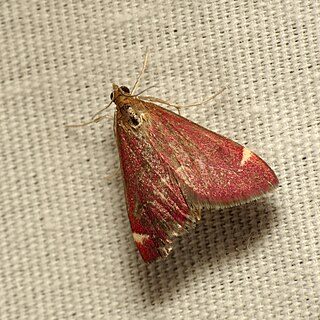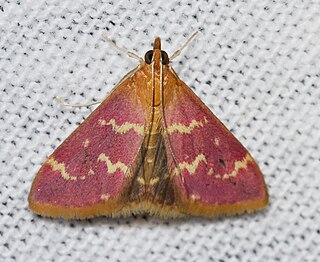Pyrausta californicalis, the California pyrausta moth, is a moth in the Crambidae family. It was described by Alpheus Spring Packard in 1873. It is found in North America, where it has been recorded from British Columbia to California.
Pyrausta cardinalis is a moth in the family Crambidae. It was described by Achille Guenée in 1854. It is found in Florida, Cuba, the Dominican Republic and on the Virgin Islands and Puerto Rico.
Pyrausta coccinea is a moth in the Crambidae family. It was described by William Warren in 1892. It is found in North America, where it has been recorded from California.
Pyrausta dapalis is a moth in the Crambidae family. It was described by Augustus Radcliffe Grote in 1881. It is found in North America, where it has been recorded from California and Oregon.

Pyrausta grotei is a moth in the Crambidae family. It was described by Eugene G. Munroe in 1976. It is found in North America, where it has been recorded from Washington, Oregon, Montana, California, Utah, Colorado, Wyoming, Nevada, Arizona and Texas.
Pyrausta homonymalis is a moth in the Crambidae family. It was described by Eugene G. Munroe in 1976. It is found in North America, where it has been recorded from Missouri to Virginia, Mississippi and Florida, west to Texas.

Pyrausta inornatalis, the inornate pyrausta moth, is a moth in the family Crambidae. It was described by Charles H. Fernald in 1885. It is found in United States, where it has been recorded from Arizona, California, Florida, Kansas, Louisiana, Missouri, Oklahoma, Tennessee and Texas. It is also found in Mexico.
Pyrausta insignitalis, the dark-banded pyrausta moth, is a moth in the Crambidae family. It was described by Achille Guenée in 1854. It is found in the United States, where it has been recorded from Florida and South Carolina. It is also found on the West Indies, as well as in Central and South America.
Pyrausta klotsi is a moth in the Crambidae family. It was described by Eugene G. Munroe in 1976. It is found in North America, where it has been recorded from southern Arizona, New Mexico and Texas.
Pyrausta lethalis, the lethal pyrausta moth, is a moth in the Crambidae family. It was described by Augustus Radcliffe Grote in 1881. It is found in North America, where it has been recorded from California to southern Nevada, southern Arizona and Texas.
Pyrausta morenalis is a moth in the Crambidae family. It was described by Harrison Gray Dyar Jr. in 1908. It is found in North America, where it has been recorded from Washington to California and west to Texas and Nevada. It is also found in Mexico.
Pyrausta nexalis, the fulvous-edged pyrausta moth, is a moth in the Crambidae family. It was described by George Duryea Hulst in 1886. It is found in North America, where it has been recorded from Washington, Montana, Arizona, California, New Mexico, Oklahoma, Texas and Utah.
Pyrausta pythialis is a moth in the Crambidae family. It was described by William Barnes and James Halliday McDunnough in 1918. It is found in North America, where it has been recorded from Manitoba and Saskatchewan.
Pyrausta retidiscalis is a moth in the Crambidae family. It was described by Eugene G. Munroe in 1976. It is found in North America, where it has been recorded from Texas.
Pyrausta roseivestalis is a moth in the Crambidae family. It was described by Eugene G. Munroe in 1976. It is found in North America, where it has been recorded from California and southern Arizona.
Pyrausta sartoralis is a moth in the Crambidae family. It was described by William Barnes and James Halliday McDunnough in 1914. It is found in North America, where it has been recorded from California and Arizona.
Pyrausta semirubralis is a moth in the Crambidae family. It was described by Alpheus Spring Packard in 1873. It is found in North America, where it has been recorded from southern British Columbia to California, Nevada, Colorado and Arizona. The habitat consists of coastal areas, reaching inland up to altitudes of about 9000 ft.

Pyrausta signatalis, the raspberry pyrausta moth, is a moth in the family Crambidae. It was described by Francis Walker in 1866. It is found in North America, where it has been recorded from British Columbia to Ontario, south to North Carolina, South Carolina, Texas and Arizona. The habitat consists of aspen parkland and grasslands.

Pyrausta tyralis, the coffee-loving pyrausta moth, is a moth in the Crambidae family. It was described by Achille Guenée in 1854. It is found in the United States, where it has been recorded from New York to Illinois and from Florida to Arizona. It is also found from Mexico to Venezuela, as well as on the West Indies.
Pyrausta volupialis, the volupial pyrausta moth, is a moth in the Crambidae family. It was described by Augustus Radcliffe Grote in 1877. It is found in North America, where it has been recorded from Oklahoma, Utah, Texas, Colorado, New Mexico, Arizona and California to Chiapas, Mexico.






